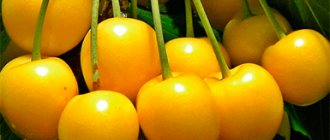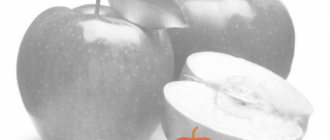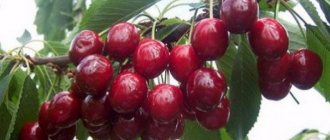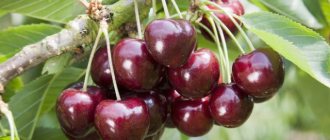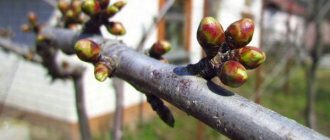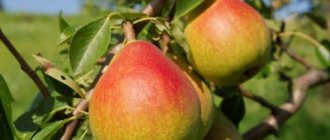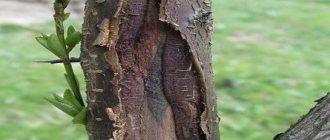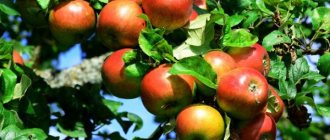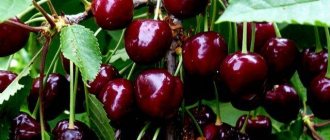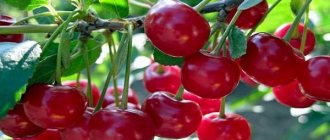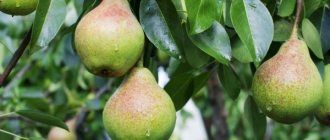Cherry variety
There are different varieties of cherries. In addition to taste, they differ in acceptable climatic conditions and the method of formation of ovaries.
All varieties of cherries can be divided into 3 groups:
- self-sterile. Only 5% of ovaries are able to set without pollination by pollen from trees of other varieties;
- partially self-fertile. No more than 20% of ovaries are formed;
- self-fertile. Capable of forming over 50% of ovaries without pollination from other varieties.
Therefore, it is necessary to plant cherries of compatible varieties nearby. Thanks to this, all the trees will pollinate among themselves and bear fruit well. The main thing is that the trees coincide in flowering time.
Pollination
When cherries have good and regular flowering, but the berries do not set, then the lack of a pollinator could lead to this situation. Cherry is a plant that is not divided into male and female. Each of its varieties requires the presence of another type of cherry nearby in order to achieve cross-pollination. Insects act as assistants in this process.
Cherries should not be used as a pollinator for this purpose.
Most cherry varieties are self-sterile, so planting should be done in groups, that is, it is necessary to plant 2-3 individuals of different varieties of cherries with the same flowering period. I also select several self-fertile varieties, but they produce no more than 10% of their capacity.
The main reasons for the lack of berries
| 7ogorod.ru » src=»https://qlumba.com/wp-content/uploads/2019/06/fmg5d131b539ca914.jpg» alt=»table_pic_» width=»1024″ height=»576″ srcset=»https:/ /qlumba.com/wp-content/uploads/2019/06/fmg5d131b539ca914.jpg 1024w, https://qlumba.com/wp-content/uploads/2019/06/fmg5d131b539ca914-300×169.jpg 300w, https:/ /qlumba.com/wp-content/uploads/2019/06/fmg5d131b539ca914-768×432.jpg 768w" sizes="(max-width: 1024px) 100vw, 1024px" /> | Excess of organic matter |
Causes:
If fertilizer standards are not observed, there is an excess of nitrogen, which negatively affects the formation of fruits.
Signs:
- the bushes begin to fatten:
- increase green mass;
- fruiting decreases;
- plants become more vulnerable to diseases and do not tolerate wintering well.
What to do:
- Correctly apply fertilizer in the specified dosage. fertilizing
- Place organic matter in the soil in the fall.
- In spring, nitrogen fertilizers are applied once, the dosage is reduced by 2 times
Incorrect pruning
Causes:
Another reason for the lack of berries. The vine has fruiting eyes from which shoots with flowers grow. They go from 4 to 8 eyes from the bottom. In some varieties they go from 8 to 12 eyes.
Signs:
If the vine is pruned too short, the fruiting eyes are cut off. The vineyard does not bloom or bear fruit.
What to do:
- Study the characteristics of varieties.
- Trim according to recommended patterns for a particular variety
cdn.nashvillescene.com » src=»https://qlumba.com/wp-content/uploads/2019/06/fmg5d131b584208f5.jpg» alt=»table_pic_» width=»960″ height=»651″ srcset=»https ://qlumba.com/wp-content/uploads/2019/06/fmg5d131b584208f5.jpg 960w, https://qlumba.com/wp-content/uploads/2019/06/fmg5d131b584208f5-300×203.jpg 300w, https ://qlumba.com/wp-content/uploads/2019/06/fmg5d131b584208f5-768×521.jpg 768w" sizes="(max-width: 960px) 100vw, 960px" />
Poor pollination
Reasons: A bush with a female type of flowering, and there is no pollinator nearby at the planting site.
Signs: The grape bushes bloom, but then fall off and do not form ovaries.
What to do:
- The pollen is independently transferred with a brush from the bisexual variety to the flowers of the female grape bush. face brushes.
- Artificial pollination is carried out in the morning or on a cloudy day 2-3 times during flowering.
- Plant the Kishmish grape variety nearby for natural pollination
nfbba.org » src=»https://qlumba.com/wp-content/uploads/2019/06/fmg5d131b5b5dfb43.jpg» alt=»table_pic_» width=»1024″ height=»768″ srcset=»https:/ /qlumba.com/wp-content/uploads/2019/06/fmg5d131b5b5dfb43.jpg 1024w, https://qlumba.com/wp-content/uploads/2019/06/fmg5d131b5b5dfb43-300×225.jpg 300w, https:/ /qlumba.com/wp-content/uploads/2019/06/fmg5d131b5b5dfb43-768×576.jpg 768w" sizes="(max-width: 1024px) 100vw, 1024px" />
Freezing of the vine
Reasons: With poor shelter, the grapes froze in winter and stopped bearing fruit.
Signs:
- Check the fruiting eyes on young vines - cut lengthwise.
- There is a green bud in the center - everything is fine.
- If the bud is brown, it is frozen.
What to do:
- Carry out spring pruning.
- Remove damaged shoots to the very base.
- Replacement buds and fruitful shoots will begin to form
cvet-dom.ru » src=»https://qlumba.com/wp-content/uploads/2019/06/fmg5d131b6134fd07.jpg» alt=»table_pic_» width=»1024″ height=»683″ srcset=»https ://qlumba.com/wp-content/uploads/2019/06/fmg5d131b6134fd07.jpg 1024w, https://qlumba.com/wp-content/uploads/2019/06/fmg5d131b6134fd07-300×200.jpg 300w, https ://qlumba.com/wp-content/uploads/2019/06/fmg5d131b6134fd07-768×512.jpg 768w" sizes="(max-width: 1024px) 100vw, 1024px" />
Landing location
Causes:
If the seedlings are planted in the wrong place, even 3-year-old grapes will not bear fruit.
Signs:
The vineyard grows successfully, grows greenery, but does not form ovaries even with proper care.
What to do:
- Check the landing site. The northern parts of the site are not suitable.
- Transplant the bushes to a well-lit place with sufficient sunlight.
- Choose southern and southwestern areas
Why don't cherries bear fruit?
This phenomenon can be explained by several factors, including the pollination characteristics of this stone fruit crop and its growing conditions.
Pollination rules
- Beginning gardeners should know that they will get their first harvest from cherries five to seven years after planting them. The tree bears fruit at full strength after 10-12 years.
- Most varieties of this fruit crop are self-sterile, that is, they require close proximity to pollinating plants. To achieve maximum cross-pollination, plant at least three varieties of cherries in the garden, the flowering dates of which will coincide.
- You can alternate cherries with cherries on your plot, having learned the axiom: cherries always pollinate cherries, cherries never pollinate cherries. True, cross-pollination in cherry trees is much more successful than in cherry trees. Therefore, cherries bear fruit more intensively.
- “Narodnaya Syubarova” is the name of the self-fertile cherry variety. Experienced summer residents are well aware of the partially self-fertile varieties - “Ovstuzhenka” and “Iput”. But self-fertile and partially self-fertile crops only benefit from cross-pollination, bringing more fruits of excellent taste.
By the way, it is “Iput” and the “Chermashnaya” variety that are considered universal pollinators for all cherries in central Russia.
Why doesn't it bear fruit?
Bad weather during tree flowering also does not contribute to high yields. Pollinating insects are afraid of dampness and coolness, and pollen loses its “fertile” properties in extreme heat.
A cherry tree does not bear fruit if you do not fertilize the soil in time. Proper feeding looks like this:
- in the fall, apply 70 g of potassium and 200 g of phosphorus fertilizers;
- in spring - urea (70 g);
- as soon as the cherry blossoms, it is watered with water (10 l) with superphosphate (25 g), potassium chloride (15 g) and urea (15 g);
- two weeks later, the tree is “nourished” with this solution again.
Cherries grow well in fertile soils with neutral acidity, but do not like waterlogged soil and lack of air for the roots.
An excessively thick crown is another enemy of productivity: cherries need sunlight. It is necessary to get rid of damaged, dried branches and those that grow inside the crown.
You can also increase the yield of cherry plantings by “healing” wounds, whitewashing trunks and methodically destroying garden pests.
We must remember that cherries are not a particularly winter-hardy crop and often do not bear fruit due to freezing of the buds.
By reading the corresponding article on our resource, you can find out how to prune apricots and cherries.
Agronomists recommend
In recent years, breeders have developed several cherry varieties that produce tasty berries and have increased resistance to frost.
- The sweetest, mid-late ripening are “Veda”, “Revna”, “Sinyavskaya”, “Rossoshanskaya Zolotaya”.
- A little more sour, but also very juicy - “Pink Pearl”, “Leningradskaya Black”, “Bryanskaya Pink”, “Compact Venyaminova”, “Venus”, “Fatezh”, “Diana”.
- The most frost-resistant and no less tasty are “Slava Zhukova” and “Yulia”.
Cherry feeding (video)
And a little advice for those who did not have time to plant cross-pollinators for their cherries on their plot. Try to find a flowering pollinator branch and place it in a bucket of water near the flowering cherry tree. Perhaps soon you will be pleased with the first cherry berries.
DachaDecor.ru
What to do if cherry ovaries fall off
For normal fruiting, cherry and many other trees (if we are not talking about self-fertile varieties) need a pollinator tree to grow nearby (at a distance of no more than 25-35 m). If there are no pollinating varieties nearby, plant such a tree on your site.
Fertilizing applied in the first 2-3 weeks after flowering of the tree plays an important role. 10 days after the tree has finished flowering, spray the tree crown with a urea solution (1 tablespoon per 10 liters of water). Repeat the same treatment after 10-15 days.
Most Read Reviews
Vermicompost for cucumber Grapes Isabella Grapes Muscat Grapes delight Gooseberry pests Pear early ripening Yellow cherries Seedlings of cucumbers turn yellow How to grow plums How to pollinate tomatoes How to water peppers How to plant a pear How to protect strawberries Calcium nitrate Strawberry Marmalade Strawberry Mashenka Strawberry Roxana Strawberry albion When strawberries bear fruit Raspberry hussar M Ulching cucumbers Mulching of tomatoes crumble berries why the tomatoes are withering why cucumbers disappear why the plum dries why the tomatoes are blackened by vaccination of grapes. Reproduction of lemon. Propagation of the rust of rust on cucumbers mesh for cucumbers. How much blooming lines of gooseberry varieties of sessions of the varieties honey than feed gooseberries than useful grapes black raspberries
Why do cherry leaves curl and berries burst?
The leaves of the cherry tree curl also because it is regularly attacked by the leaf roller, a parasite that also eats up buds, berries and destroys inflorescences. Among other things, this caterpillar, penetrating under the bark of a tree, eats its passages, thereby damaging the trunk of a seedling or an adult specimen.
Such cherry pests cause a lot of trouble, and fighting them requires the mandatory use of strong drugs and radical methods. To get rid of the consequences of the life activity of the leaf roller, specialists not only clean all damaged parts, but also treat them with chlorophos.
Another dangerous insect and the reason why cherries burst intensively and their fruits become unfit for consumption is the pipe roller. In this situation, gardening experts recommend using products such as Corsair, Actellik or Metafox to quickly deal with this scourge.
Prevention
The first preventive treatment is carried out before the juice begins to flow. Before doing this, do not forget to trim the tree branches and treat the resulting wounds with garden varnish. The trunks and branches should be whitened with lime.
To prepare a solution for processing cherries, dissolve seven hundred grams of urea in a ten-liter bucket of water. Spray the plant itself and its tree trunk with this composition. Urea will help protect the tree from harmful insects and dangerous fungal diseases. In addition, the plant will receive the necessary nutrients. However, treatment is carried out before flowering. After all, urea will cause a kidney burn.
If you are late with the deadline and the buds are already swollen, and you would like to protect the tree from misfortunes, then we recommend using acarin, nitrafen, agravertin, fitoverm or similar substances.
Acidic soils
Not only cherries, but also sweet cherries prefer soil with a neutral or alkaline environment. If the soil in the area is highly acidic, then you should not expect rapid growth and a good harvest. Therefore, when choosing a place to plant, you should treat the process with full responsibility.
Factors by which it can be determined that the soil is not suitable for a tree:
- branches and trunk grow less than 20 centimeters per year;
- on the crown there are bare whips with no branches;
- the trunk is covered with numerous microcracks through which gum seeps;
- a large number of flowers fall off without leaving an ovary.
If all these signs or at least one are noticed on a cherry tree, then it is worth normalizing the acidity of the soil. To do this, pour a bag of lime or dolomite flour under the tree.
Reason 3: bad year for cherries
Does your cherry tree not bloom after winter, although everything was fine before? Perhaps the reason was a bad weather year.
For example, we may be talking about too warm autumn. Prolonged sunny autumn days with positive temperatures can force the cherry tree to “awaken” again before winter instead of entering a dormant period. And then new weak shoots with flower buds freeze with the inevitable sharp onset of cold weather. In this case, next spring, with a high degree of probability, ovaries will not form.
Another common cause of problems with cherry blossoms is late spring frosts. Even a temperature of -1°C can cause irreparable damage to a tree ready to bloom, and at a thermometer reading of -4–5°C, even formed buds and flowers can die.
If such frosts are not uncommon in your latitudes, choose late-flowering varieties ( Shchedraya
,
Beauty of the North
,
Bagryannaya
,
Ural Ruby
,
Orleya
,
Lyubskaya
, etc.) or take care to curb early flowering (for example, whitewash the trunk and bases of skeletal branches, which will not allow the tree tissue to get too hot in the sun). In early spring, cherries can be pre-treated with special stimulants to increase resistance to adverse weather (Epin Extra, Novosil, etc.).
Also, when warm weather has already established, but there is a sudden forecast of sharp frosts, smoke or sprinkling methods are used. In the first case, before dawn and for a couple of hours after it, the tree is fumigated with warm smoke from smoldering fires or special smoke bombs placed nearby in advance. In the second, simulating natural precipitation, the garden is sprayed with water from a fine sprinkler at night before sunrise so that the frozen water retains heat on the branches.
Very cold or hot temperatures in the spring, excess rain and other weather disturbances can also interfere with flowering. All this negatively affects both the viability of flower pollen and the activity of pollinating insects.
Or perhaps your cherry is just tired and is now resting. She could get tired from the difficult climate or, for example, poor soil. Quite often, to save the strength of fruit trees, nature provides the following mechanism: they bear fruit every other year, resting from time to time, and then again please with a good harvest.
Blueberry diseases and their treatment
Any fungal infection spreads very quickly. At the same time, it also damages healthy bushes located in close proximity to the diseased plant. Therefore, it is necessary to act immediately after detecting the first symptoms of the disease.
Since there are many diseases, the fight against each requires a special approach:
- Stem cancer. The plant is treated with one of the modern means - “Topsin” or “Euparen”. The spraying process is repeated 3 times. The first and second times are carried out before flowering at intervals of a week, the third - after harvesting the berries. Affected branches are pruned and burned to prevent spread.
- Phomopsis. One of the control options is also considered to be pruning damaged stems and then burning them. Chemicals such as Topsin, Euparen or Fundazol will also help. The spraying procedure is carried out similarly to that described above when fighting stem cancer.
- Moniliosis and anthractosis. Branches showing signs of disease are pruned. They must be burned.
- Spotting. The bush is treated with Bordeaux mixture. Leaves damaged by the disease are raked into one place and burned. Spraying with karbofos or fufan is allowed before the flowers appear.
- Gray rot. The control method is similar to the described actions for stem cancer.
If a fungal infection damages the berries, they should be picked immediately. If such berries remain on the bush, the fungus survives the winter in them and infects new shoots in the spring. Chemicals from the group of fungicides are effective against any such infections.
The most common blueberry pests are:
- Caterpillars of various insects. They eat leaves.
- Aphid. Reduces the development of young shoots and spreads various infections.
- Flower beetle It feeds on buds and young buds of the plant.
- Leaf roller. It slowly envelops the tops of branches in a web, where it eats leaves and buds.
- Kidney mite. Damages the buds, which leads to the death of the leaf.
- Chafer. It feeds not only on flowers and young leaves, but also on plant roots.
Insecticides are considered a useful means of pest control.
In spring, it is also recommended to remove damaged buds. Some birds eat blueberries. To scare them away, shiny objects are used that are hung on bushes. In addition, you can cover the bushes with mesh.
Processing method to prevent berries from falling off
The first processing procedure is carried out before the juice begins to flow. But before this, it is necessary to cut off excess or dry branches, cover it with varnish, and whitewash the trunk and branches with lime.
Urea is perfect for treatment; it should be sprayed onto the plant and the tree trunk. This will help avoid diseases, fungi and insects. But the first procedure should be carried out before the flowering period, otherwise the urea will cause burns to the buds.
If time is lost and the buds are already swollen, you need to use special substances that will not harm the buds, will boost the cherry’s immunity and protect it from environmental influences. Then the berries will not fall off.
Advice. When flowering begins, you need to feed the plant with chicken droppings. In the summer, it is necessary to treat it twice with nitrogen fertilizers. After the harvest is harvested, organic fertilizers must be applied. In the fall you need to add mineral nutrients.
Why don't cherries bear fruit?
Cherry is an unpretentious tree that bears fruit annually for many years. There are old-timers among them, who are almost a hundred years old. This is their biological feature. Sweet cherries are less susceptible to attacks by various pests than sour cherries. But there are cases when a tree, due to its fruitful characteristics, for some reason refuses to bear fruit and stands without a harvest, like an ornamental tree. Beginning gardeners are concerned about this fact. Cherries don’t bear fruit, what should I do? It is necessary to analyze the most common reasons for the lack of flowering and try not to repeat them.
It's not time to bloom
The fruiting period depends on the variety zoned in the region. Therefore, buyers need to ask what variety they are taking, as well as in what year the purchased cherries of this variety will bear fruit.
Cherry blossom time
Drop off point
The reason that the cherry tree does not bloom may be the wrong location. You can expect flowering if the tree is planted in the southern or southwestern part of the garden. The tree does not like drafts, so it should be protected from them and from the cold north wind. Recommendations for planting cherries indicate how to plant the tree. If the planting technology was violated and the root collar was deepened into the ground, this will slow down fruiting. The root collar should be at soil level. Flowering and fruiting are affected by the proximity of the roots to groundwater. Cherry does not tolerate wetlands and lowlands. In this case, it is recommended to pour drainage into the hole before planting.
The root collar was deepened into the ground
The soil where cherries grow
The tree “lives” well on fertile soil that has neutral acidity; it prefers moderate watering followed by loosening the soil to allow air to reach the roots. It is usually recommended to water three times during the summer if the season is too dry. After harvesting, the tree is watered once at the end of September.
Poor tree lighting
The cherry tree should be sufficiently illuminated by direct sunlight, from morning to evening or at least until noon. It should not be in the shade of taller trees. It is recommended to maintain a distance between trees of up to 5 meters.
Fertilizer application
The lack of flowering can be affected by improper care - the tree is not fed with fertilizers at the right time. Experience shows that the correct approach would be: fertilizing with potassium (70 g) and phosphorus (200 g) fertilizers in the fall, and fertilizing with urea (70 g) in the spring.
Attention! With an excess of nitrogen fertilizers, cherries can begin to force out branches and leaves - fattening. A cherry tree can bloom and even an ovary appear on the branches, but then the tree sheds the ovary
This occurs when the soil is infertile and there is a lack of potassium and calcium. This situation can be corrected by introducing complex fertilizers into the soil.
The cherry tree can bloom, and even an ovary may appear on the branches, but then the tree sheds the ovary. This occurs when the soil is infertile and there is a lack of potassium and calcium. This situation can be corrected by introducing complex fertilizers into the soil.
Many gardeners fertilize the tree with green fertilizers, to which the cherry tree responds with abundant flowering and fruiting in the future. To obtain these fertilizers, gardeners plant peas around the crown of the cherry tree in the summer, which they mow and plant in the ground in the fall.
Fertilizer application
Trimming
A crown that is too thick means losing part of the harvest. To flower and bear fruit, a tree needs sunlight, which cannot penetrate into the middle of the tree through the dense crown and foliage. The crown forms in the shape of a bowl over several years. Sunlight will freely penetrate into it, the cherry will bloom and bear fruit. No further pruning is done, only dried and damaged branches are removed.
Pests and diseases
To prevent pests from depriving gardeners and summer residents of their cherry harvest, it is recommended to spray the plants with 3% Bordeaux mixture even before the leaves bloom. During the growing season, the treatment is repeated, but the concentration is reduced, a 1% solution is used.
If you eliminate the consequences of the shortcomings that were made when planting cherries, in 2-3 years the owners of the gardens will be able to enjoy their delicious berries. In the future, they will be able to take measures to increase the fruitfulness of cherries.
Factors influencing cherry fruiting
Let's consider the factors that directly affect fruiting.
Assortment (incorrect variety)
Sweet cherry is a heat-loving crop, adapted to the Mediterranean and temperate climates of southern Europe.
In cold regions, it is necessary to grow specialized varieties of cherries adapted to local conditions.
Some varieties are comfortable in Moldova, in many regions of Ukraine, in the North Caucasus, and in the Krasnodar Territory. New selections are being developed in regions of Russia with a continental climate - the Middle Volga region, Moscow region, Leningrad region, Far East, certain regions of the Urals and Siberia. The characteristic “winter-hardy variety” for the Caucasus and for the Moscow region are completely different concepts ; When selecting cherries for your garden, you need to read detailed descriptions and reviews from experienced gardeners.
The main reason for poor fruiting of cherries is poor selection of varieties. Sweet cherries are less frost-resistant than cherries or plums. For areas with cold winters and springs, special varieties with winter-hardy wood are needed, whose buds can withstand winter frosts and return spring frosts. Forms with late flowering are also promising (this saves flowers from return frosts).
Varieties
Bryanskaya Pink cherry is a winter-hardy variety with stable yields, recommended for Central Russia.
Modern assortment of cherries for Central Russia: Bryanochka, Bryansk pink, Veda, Gronkavaya, Zorka, Iput, Beauty, Krasnaya Gorka, Lena, Leningradskaya black, Narodnaya, Ovstuzhenka, Odrinka, Orlovskaya pink, Orlovskaya amber, In memory of Astakhov, Pobeda, Gift of Ryazan , Gift to Stepanov, Raditsa, Revna, Rechitsa, Rodina, Pink Sunset, Sadko, Northern, Symphony, Teremoshka, Tyutchevka, Fatezh.
Many of these varieties (Fatezh, Ovstuzhenka, Teremoshka, etc.) have proven themselves well in the North-West, Siberia and the Urals.
Pollination
Most types of cherries need “neighbors” - other varieties blooming at the same time that will pollinate each other.
If the cherry blossoms profusely, but does not set fruit (even if there have been no frosts), then the reason lies in the absence of a pollinator. This crop is not divided into males and females, but each variety requires another variety of cherries nearby for cross-pollination (via insects). Cherries are not suitable for this purpose.
It is necessary to pay attention to the possibility of self-pollination of cherries.
Most cherry varieties are self-sterile, and they need to be planted in groups of several different varieties (2 is not enough, preferably 3-4) with simultaneous flowering dates. There are partially self-fertile varieties, but they themselves produce only 5–10% of their potential berries (Ovstuzhenka, Revna, Euphoria, Ariadna, Krasa Zhukova).
Wintering
Cherries are preparing for winter.
Even in hardy varieties, flower buds and entire branches can die in severe winters, and then the tree hardly blooms in the spring. What help can a gardener provide to cherries to minimize the risk of winter freezing?
- Increasing winter hardiness (required).
- Winter cover with snow (as a possible option).
Increasing winter hardiness
The harvest depends on how the cherries withstand the winter!
Healthy cherry plants that develop in comfortable conditions are better prepared for winter and survive it more successfully. During the season, the wood matures and fruit buds are actively formed.
- landing NOT in a cold lowland; groundwater no closer than 4–5 meters;
- placement of plants without shading;
- if the soil is highly acidic (pH less than 5.5), deoxidation with Dolomite flour is necessary: 500 g in the hole when planting, then adding 300–500 g per 1 sq.m. every 3 years. m of tree trunk circle for digging;
- competent pruning and shaping (required!);
- watering only in dry weather and in the first half of the season;
- nitrogen fertilizing irrigation (water infusion of manure 1:10) is appropriate at the beginning of the season, phosphorus-potassium foliar feeding - in August and early September (a tablespoon of potassium sulfate and superphosphate per 10 liters of water);
- pre-winter water-recharging irrigation (in October or early November, 60–100 liters per tree);
- treatment and prevention of fungal diseases that weaken plants (coccomycosis and moniliosis are especially dangerous): late autumn (after leaf fall) and early spring (strictly before the buds swell) spraying (300 g of iron sulfate per 10 liters of water); during the growing season, treatment with fungicides ( Horus, Skor, Plantenol, Bordeaux mixture - according to the instructions). Most modern varieties are disease resistant.
One of the ways to preserve cherries in winter.
Snow shelter
By their nature, cherries are tall trees. Northern experimental gardeners are trying to artificially reduce their height by using bush and fan formations and grafting onto low-growing cherries.
At the beginning of winter, low plants are covered with snow, which protects them from freezing. Scientists and breeders strive to develop low-growing forms.
It is necessary to promptly process and treat frost damage - winter damage to the bark, branches and trunk. Such wounds weaken the trees, serve as a gateway for infections, and can lead to infertility and death of the plant.
Spring return frosts
Cherries are preparing for a new harvest. Spring has come, leaves and buds will soon appear.
Cherries bloom quite early. Its flowers are relatively resistant to cold snaps (in this, cherries are superior to many varieties of cherries and plums), sometimes maintaining the ovaries even at negative temperatures of minus 4 degrees.
But there are also more severe frosts that are destructive to flowers.
Frosts are stronger in the ground zone, and in the northern regions, those flowers that bloom on the high treetops have a higher chance of surviving. This is why many experienced northerners prefer the tree-like form for cherries. On the other hand, a low bush-like crown can be easily protected from freezing temperatures by covering it with agrofibre.
Why cherries don't bloom and how to fix it
Even birds love the sweet taste of cherries. There is a legend that it was birds who brought it in ancient times.
Nowadays, up to 4,000 varieties of cherries are grown in the world. In many countries it is sold in stores all year round and is always fresh. The French make wine from it.
Cherries are very healthy, they contain sugar, which is easily digestible, minerals and various vitamins, a small amount of vitamin C and nicotinic acid. This berry has a wonderful taste and is widely used in cooking. Its fruits strengthen blood vessels and are considered an excellent cure for anemia.
The cherry tree usually bears fruit annually. Various harmful insects attack it less than cherries. However, there are periods when cherries do not bear fruit. One of the reasons for this is the lack of flowering. Let’s try to figure out why the cherry tree doesn’t bloom now. Let's find out the most common reasons for this phenomenon, and why the tree does not produce a harvest.
One of the possible reasons for the lack of flowering buds in cherries is a poor root system of the tree or seedling. The reason for the underdevelopment of the root system of a fruit tree may be improper planting technology.
Another reason why cherries do not bloom is that the gardener chose the wrong place for planting. What you need to do to fix the error:
- the tree is planted on the south side of the dacha;
- the area where cherries grow must be protected from wind and drafts;
- it cannot be planted near other trees, they will create shadow, but cherries love the sun;
- the tree needs to be rooted in light, airy soil;
- it cannot be planted close to groundwater, as this will cause the roots to rot and, as a result, the tree will not produce a harvest.
Another possible reason is that the landing was carried out incorrectly. If the gardener does not have experience, then it is likely that he will plant the tree incorrectly. To get a good harvest when planting, you must follow the instructions:
- make a hole for the cherry seedling 60 cm deep and 80 cm wide. Add a little humus and fertilizer to it;
- the root collar should be at soil level. It cannot be buried very deeply;
- You need to make a shaft around the seedling and water the soil well where the cherry will grow.
Too much or little moisture is also one of the reasons why a tree does not bloom or bear fruit. In the summer, the tree is watered three times, the soil needs to be loosened a little, and in the autumn it is necessary to irrigate.
The tree may also not be pollinated, which is also worth noting as a reason. Many varieties of sweet cherries need to be planted next to cherries, as they do not pollinate themselves, and they must be near other trees to do so. When there are no cherries near the cherry tree, it will not bloom or bear fruit.
Over the past fifteen years, cherries have begun to be grown in the Moscow region. It tolerates winter very well and bears fruit well. But to plant a tree, it is advisable to choose a place that is protected from the north wind. It is best to plant cherries on the south side of the house. The walls of the house will protect the tree from the wind.
Of the many interesting varieties, it is necessary to highlight the columnar cherry, which has taken root well on the soil of the Moscow region and in places with a similar climate. The name “columnar” speaks for itself. The tree has a unique shape in the form of a column, the trunk grows 3-4 m upward, the fruiting skeletal branches are very short, the crown is in the form of a cylinder.
Now that we have told you what reasons affect the flowering of cherries, you will definitely eliminate them, and then in 2-3 years you will be able to enjoy its beautiful flowering and eat its sweet fruits.
https://youtube.com/watch?v=fe5fbOEw0qg
Autumn nutrition of cherries after harvest
What to do if the orchid's roots dry out
Fertilization in the fall plays a significant role in the development of the plant. During the period when the tree bore fruit, it gave almost all its strength. They need to be restored with the help of fertilizing.
In the spring, when the tree comes to life, it will receive all the necessary nutrients. The tree needs time to absorb nutrients, especially when it comes to root feeding. Fertilizers must be applied evenly.
To properly apply fertilizing after harvesting, it is necessary to combine organic and mineral fertilizers. Organic matter is added directly to the root. This could be rotted manure or compost. You can cover the tree with peat.
Organic matter must be added dropwise at a distance from the stem circle, depending on the age of the tree. The roots of the cherry tree grow deep into the ground, so the backlog will be at least 20 cm. The compost layer must be well sprinkled. Constant rains or melt water in the spring should not wash away nutrients, oxygen should not have access to organic matter.
Mineral fertilizers are applied to the ground next to the tree. Superphosphate and urea will be a good remedy. This procedure can significantly increase the yield of cherries.
Fertilizers can simply be scattered on loose soil around. It is necessary that the soil is moist. Sprinkling with minerals should not be done close to the trunk. This way you can burn wood. If autumn is dry, the plant needs to be watered. Before applying mineral fertilizers, they must be dissolved in water. This way the nutrients will go directly to the roots.
When feeding a young seedling, it is necessary to add 100 g of urea and superphosphates. For an adult tree, the given amount per 1 sq.m. will be sufficient. Minerals should not be applied close to the trunk. The roots, which absorb nutrients as much as possible, are located around the circumference of the tree, and not in the center.
Nutrient deficiencies
Cherry is a very demanding crop when it comes to soil quality. This tree bears fruit well in soil with a neutral acidity level.
It is also important not to plant the tree in places where groundwater flows close or in wetlands. The depth of groundwater passage must be at least 1.5 m
In a peat bog, cherries will not develop and bear fruit well. To improve the fertility of such soil, it needs to be limed. If the soil is almost completely sandy, you need to add some clay to it, and it is better to regularly apply organic fertilizers.
If the soil is too calcareous, the cherries will also not bear fruit well. Boron must be added to such soil; it is necessary for the formation of ovaries.
- Juniper stricta - description, cultivation, planting and care. Secrets of garden maintenance and application in landscape design (130 photos and videos)
- How to grow a plum from a seed: tips and tricks on how to prepare the soil, prepare fertilizers and grow plums at home (155 photos + video)
- Cherry cherry: 100 photos, description of the variety, features of planting and cultivation. Care, planting and replanting of cherries
Surviving winter time
It happens that even hardy plants have buds that die in winter. Sweet cherries are no exception. During periods of frost, entire branches may die, which is why the tree will not bloom in the spring.
To avoid such situations, you will need to take several important steps.
- Increase the winter hardiness of cherries. This can be achieved by planting in cool lowlands, positioning the tree without the presence of shade, pruning it correctly and forming a crown. The tree will become more adapted to the cold if you water it only in dry weather and apply nitrogen and phosphorus-potassium fertilizers.
- In winter, cover the cherries with snow. Hilling up with snow will help protect the plant from freezing. If the bark or branches are damaged in winter, they should be treated immediately. Also, wounds will cause weakness of the cherry, its infertility and pain.
The lack of fruiting in cherries can be explained by many factors. Many of them are associated with poor plant care, as well as insufficient knowledge of the characteristics of the variety. This tree will not require much effort from the gardener in order to produce a bountiful harvest. The main thing is to follow at least the basic rules and pay a little attention to the cherries.
To learn how to shape cherries, see the following video.
Cherry is a valuable berry crop. Sometimes gardeners are faced with an annoying problem: why don’t cherries bear fruit? What to do if the tree produces a meager harvest? There is no definite answer; each specific case may have its own reason or a whole set of reasons. A persistent and thoughtful gardener will definitely achieve a stable harvest if his region is, in principle, suitable for growing cherries.
Using bad seedlings
The root system of the cherry tree produces a large number of seedlings. But, they are not always suitable for reproduction. Therefore, it is often not possible to simply take cherry shoots from neighbors. Regrowth does not guarantee the growth of the same variety.
The absence of fruits can also result from other reasons, such as diseases and pest activity. They happen much less frequently than those described above. But, for preventive purposes, cherries should be regularly treated with fungicides. These drugs are used to combat most diseases and pests.
It is also important to systematically take preventive measures. Weeds need to be removed in time, wounds on the trunk should be covered with garden varnish, the lower part should be treated with chalk, and regularly sprayed against fungus and pests.
Cherry blossoms, but does not bear fruit - what to do?
In our region, the common cherry is considered a fairly common tree, the fruits of which we love to eat fresh, use as a filling for dumplings and cakes, and preserve for the winter. In addition to sweet and sour berries, cherries are valued for their relative unpretentiousness. Despite this, gardeners sometimes complain that cherries bloom profusely, but, unfortunately, do not bear fruit. Of course, this fact cannot but upset, but we will try to figure out why this happens and what to do if the cherry does not bear fruit well.
Why don't cherries bear fruit?
To understand how to make a tree produce a harvest, you need to figure out why this does not happen. In general, if we talk about what year cherries bear fruit after planting, then most often the first berries should appear on the branches in 3-4 years. If this does not happen from year to year, provided that flowering does occur in the spring, measures need to be taken. So, the reasons why cherries do not bear fruit may be:
- insufficient pollination due to the absence of other varieties of cherries or pollinating insects nearby;
- freezing of buds or already opened flowers;
- insufficient care (watering, fertilizing, unsuitable soil), due to which the tree is depressed and unable to produce a harvest.
Cherry blossoms, but does not bear fruit - what to do?
To solve such an urgent problem, several solutions are proposed. Most often, cherries do not bloom because the fruit buds may freeze in the fall. Therefore, at this time of year it is recommended not to fertilize with nitrogen fertilizers and not to water at the time when the first autumn frosts occur. In the spring, during frosts, you can delay flowering by covering the cherry tree trunk with snow or mulch. If flowering has already begun, you can save the potential harvest if you cover the entire crown with fabric or non-woven material.
When thinking about how to make cherries bear fruit, be sure to pay attention to the sufficiency of pollination of your tree. Unfortunately, not all varieties are self-pollinating
Therefore, if there is no harvest for 4-5 years, it is recommended to plant a seedling of a different variety near the cherry. It also happens that pollination of buds does not occur due to the fact that pollen is not transferred by pollinating insects (wasps, bees, bumblebees, etc.). This happens due to unfavorable weather or the use of insecticides against cherry pests. Spraying a product such as Ovary, Pollen or Bud can help the buds develop an ovary without pollinators. Well, you can attract insects to the tree with the help of sweet syrup. It is prepared from a liter of water and a tablespoon of sugar. This sweetened water should be sprayed over the crown of the cherry tree.
Sometimes, in order to make cherries bear fruit, it is enough to adhere to the rules of proper care for this garden crop.
It is important to plant the seedling correctly from the very beginning.
womanadvice.ru
Who pollinates the tree
Cherry pollination is a natural process of plant fertilization, which involves the transfer of pollen from the stamens of one flower to the stigma of another. The pollen that falls on the pistil grows in the style and penetrates the ovule. The result of fertilization is the ovary, from which the berry is formed.
Most often, the tree is pollinated by insects and the wind, which carry pollen from flower to flower. But there are situations when it is not possible to carry out pollination naturally, then it is carried out by a person manually.
How to pollinate a tree by hand?
Situations are different, for example, during early flowering, when there are not yet enough insects. It also happens that trees grow in greenhouses, where access for pollinators is difficult.
Before artificial pollination, pollen maturity must be checked. Usually you check it with your hands, run your finger over it and see whether there are lumps of yellow color or not. If they are present, it is judged that the pollen is mature. Then they choose a good time, most often it is lunchtime on any warm and not rainy day.
Pollination must be done in such a way that pollen is easily transferred from one plant to another. To do this, use a brush or cotton swab.
Among the cherry varieties there are practically no self-pollinating ones, that is, those that pollinate themselves with their own pollen.
How to pollinate with different species?
Only those trees whose flowers bloom at the same time are capable of cross-pollination, otherwise the process will not end with the formation of an ovary. Interestingly, some scientists claim that cherries can be pollinated by cherries, but not vice versa.
Cherry varieties are divided into three types depending on the pollination method:
- Self-fertile.
- Partially self-fertile.
- Self-sterile.
The number of ovaries from which fruits are formed completely depends on the type of pollination.
Self-fertile varieties can pollinate themselves. This results in a rich harvest. Fruits are formed on almost every second pollinated flower. Such trees are planted by summer residents of small plots where it is not possible to plant a large garden. Popular varieties of this type of pollination are:
- Bereket;
- Dana;
- Pridonskaya;
- Goryanka;
- Tyutchevka;
- Youth;
- Crimson.
Partially self-fertile trees are those that are capable of pollinating both independently and with pollen from nearby growing plants. Of the entire mass of flowers, fruits are formed in 1/5 of them. Among these varieties are:
- Revna;
- And the way;
- Ovstuzhenka;
- Olympic;
- Compotnaya;
- Meeting.
Self-sterile are those that under no circumstances can pollinate themselves, so they need self-fertile varieties to be planted nearby. These are:
- Julia;
- Syubarovskaya;
- Robin;
- Orlovka;
- Chereshnya Yaroslavna;
- Cherry Cordia;
- Cherry Vasilisa.
Why don't cherries bear fruit?
Cherry is a tree that can bear fruit for a whole century. Various pests attack it even less than cherries, but some gardeners are sometimes worried about the fact that this tree lacks a harvest. Now let’s find out for what reasons a tree can stand without a harvest.
The first reason is that the flowering time has not come
There are varieties of cherries that give color within 3 years after planting, and there are plants that need a longer period - 5-6 years for the tree to bear fruit. Therefore, if you buy cherries, be sure to inquire about its variety, as well as when the plant will be able to bear fruit.
The second reason is the wrong choice of landing site.
The following points need to be read and done in reverse, because these are incorrect methods and methods for choosing a place and, perhaps, because of such mistakes, the cherries do not bear fruit:
- The tree is located on the north side of the dacha (should be on the south or southeast side).
- The area where the cherry grows is not protected from drafts.
- The cherry tree is planted next to other trees and is thus always in the shade.
- The plant is planted on dense, poorly air-saturated soil, on clay or peaty soil with a lot of sand.
- Cherries are planted close to groundwater, and this can cause rotting of the roots and, naturally, in this case the plant will not bear fruit.
The third reason is improper planting of cherries
Many gardeners, due to inexperience or other factors, plant a tree incorrectly. In order for your cherries to yield a harvest soon, you must follow the instructions:
- The hole into which the cherries will be immersed should be approximately 60 cm deep and have a width of about 80 cm. Humus and fertilizers must be thrown into the hole.
- Under no circumstances should you bury the root neck of a tree deeply. It should be at ground level.
- You need to make a shaft around the seedling and abundantly water the soil where the plant is planted.
The fourth reason is excess or lack of moisture
Lack or excess of water can also be the reason why cherries will not be able to bear fruit. Therefore, remember - in the hot summer you need to water the tree 3 times, loosening the soil a little each time. And when autumn comes, at the end of September you also need to irrigate the land once.
The fifth reason is lack of pollination
There are varieties of cherries that require the presence of another tree nearby; the ideal option is cherries. And this need is explained simply: some varieties of cherries cannot self-pollinate, and therefore require another plant next to them. And if there is no such thing, then the cherry tree will not be able to bear fruit.
The sixth reason is the air temperature is too low
Cherries may not bear fruit due to low temperatures, provided that this type of cherry does not tolerate frost well. Also, in the event of a long and relatively warm winter, and then a sharp cold snap, the plant may suffer. To prevent this from happening, it is necessary to dig the tree in with earth during the winter, making a high shaft, and it is also necessary to water it abundantly. It is advisable to cover the tree during the cold winter so that it does not freeze.
Now, knowing what reasons can affect the fruiting of cherries, you can anticipate them and eliminate them, and then after 2-3 years you will be able to enjoy the lush flowering of cherries and the incredibly sweet taste of their fruits.
Weather conditions
Poor fruiting of a berry tree can occur due to unsuitable weather conditions. The cherry tree will not bear fruit if there is wind, rain and frost at the time of its flowering. In hot or cloudy weather, the tree also does not feel comfortable. In such a situation, the pollen that lands on the flower does not germinate.
If the buds freeze in winter, the tree does not bloom well in the spring. Proper care of cherries will help them bloom and bear fruit regularly.
To do this, the tree should be watered every 2 weeks, fed vigorously, and the process of mulching the root part carried out.
